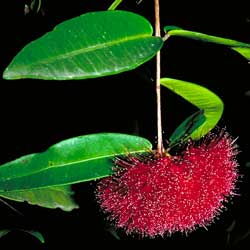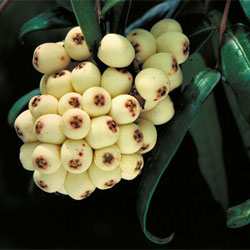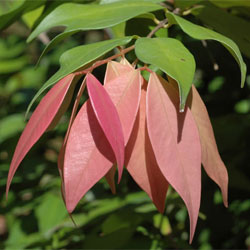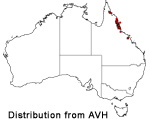Syzygium wilsonii
 |
 |
 |
Watergum, Plum Satinash
Syzygium wilsonii (F.Muell.) B.Hyland
Syzygium wilsonii belongs to the genus of Syzygium (family Myrtaceae) containing over five hundred species, fifty occurring in Australia. Also known as the Powderpuff Lillypilly, it is perhaps one of the most attractive and versatile of the "Lillypillies", though still somewhat unknown and under-used in horticulture. The lillypillies are one of the most sought after horticultural plant groups for landscaping and gardens, apart from Syzygium also include related genera such as Acmena and Eugenia.
 This
species is endemic to the far north Queensland rainforests, from Ingham to Cooktown,
in lowland rainforests from sea level to 600-700m, growing in relatively poor
soils. S. wilsonii subsp. wilsonii is suitable for a range uses
and locations from Sydney to Cairns. This species can be easily incorporated
into any patio, courtyard or rainforest garden.
This
species is endemic to the far north Queensland rainforests, from Ingham to Cooktown,
in lowland rainforests from sea level to 600-700m, growing in relatively poor
soils. S. wilsonii subsp. wilsonii is suitable for a range uses
and locations from Sydney to Cairns. This species can be easily incorporated
into any patio, courtyard or rainforest garden.
It is a small shrub 1-3 m tall with extremely attractive flowers and foliage with clusters of edible fruit that attracts wildlife. It has weeping branches with lanceolate reddish brown new foliage. Stiff narrow leaves to 18 cm x 5 cm, dark green and dull on upper surface and paler on underneath side of leaf. This species is the only one of the lillypillies to have red flowers. They have large, fluffy heads and flower from spring to summer. White clusters of ovoid shaped fleshy fruits.
The plant can be easily propagated from the seed once the flesh of the fruit has been removed. Use a 50:50 mix of sharp sand and peat moss in a sterile seed raising tray or pot to strike seeds. Keep moist but not damp. This species can be successfully struck from cuttings; the best time to take cuttings is from November to March.
Plant out in a shaded or sheltered position away from drying winds and full sun. It can also be used as a specimen shrub in a raised garden bed or against a wall. Keep the plant well mulched and composted, it’s also responds well to regular fertilizing encouraging new growth. This species responds well to regular tip pruning increasing the number of flowers produced. To increase the impact of the plant try to incorporate with other species suck as palm lilies, native gingers, ground covers and ornamental grasses. This will help create a structured garden with differing layers of height. This species can also be used as an under storey plant for a more established rainforest garden. This species is a particularly attractive potted plant making it accessible for people with smaller gardens and courtyards.
The flowers can be used to attract wildlife such as birds and honeyeaters. One of the only negatives with this species is it is a somewhat slow growing plant taking a while to become established. Syzygium species also often get infestations of black scale; the best way to control this is to use either white oil or diluted detergent.
This species is an excellent ornamental plant for a garden with its showy red puffy flowers, reddish brown new foliage and clusters of white fruits.
Text by Chris McCarthy (2004 Student Botanical Intern)
Derivation of the name: Syzygium wilsoniiSyzygium - from Greek ‘syzygos’, joined, referring to paired leaves and branchlets of a Jamaican species. wilsonii - derivation uncertain, possibly after Dr Thomas Braidwood Wilson (1792-1843) a botanical collector in the 1830s. |
References
Mansfield, D. 1992,"Australian Rainforest Plants For Your Garden", Simon & Schuster Australia, Roseville, NSW, Australia.
Jones, D. L. 1984, "Ornamental Rainforest Plants in Australia", Reed Books PTY LTD, Frenches Forest, NSW, Australia.
Radke, A., Radke, P., Sankowsky, G. and Sankowsky, N. 1993, "Growing Australian Tropical Rainforest Plants", National Library of Australia, Queensland, Australia.
Nicholson, H & N.1985,"Australian Rainforest Plants", National Library of Australia, NSW, Australia.
Australian Society for Growing Australia Plants Website, Accessed 19/1/04, URL:http://farrer.riv.csu.edu.au/ASGAP/index.html
Alstonville Tree Farm Website, Accessed: 12/02/04, URL:http://www.treefarm.com.au/Syzygium_wilsonii_wilsonii_x.htm
![An Australian Government Initiative [logo]](/images/austgovt_brown_90px.gif)

